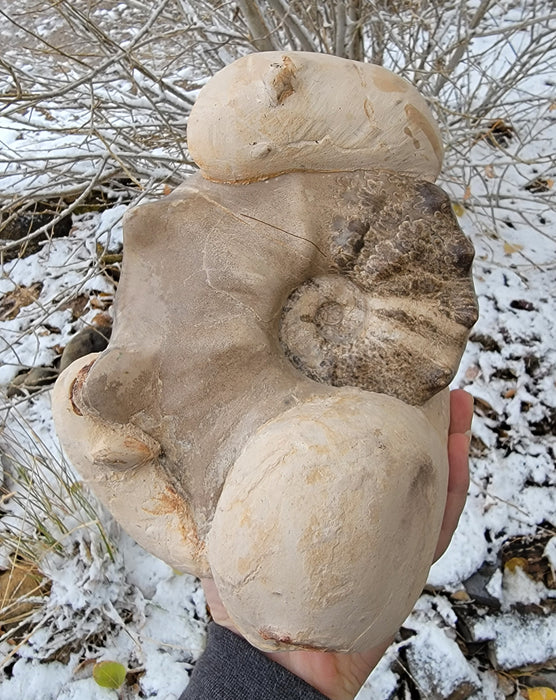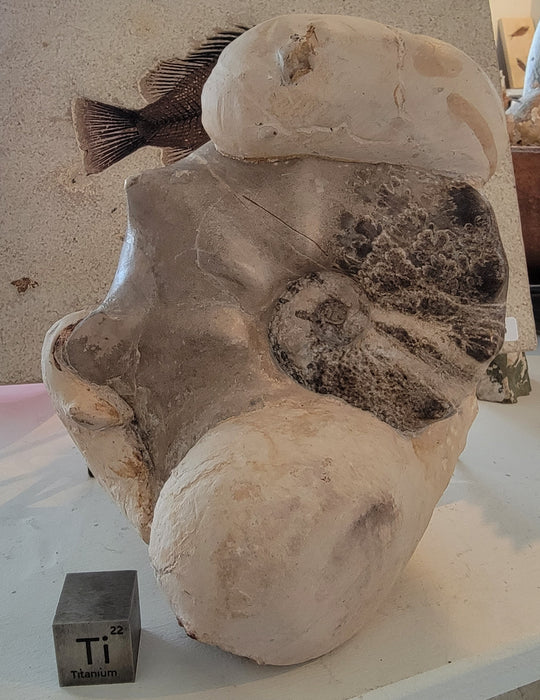
Ammonite Mammite Nodosoide | Morocco
Mammite Ammonite approx. 5.25" x 6"
Measures approx. 9" x 7" with base
Mammite nodosoides species lived in the Cenomanian and Turonian age, during the Late Cretaceous. 90 myo
It had a characteristic shell with "umbilical bullae", which are the bumpy outgrowths distributed along its sides. It was considered the prehistoric predator of the cephalopod family.
Mammites was named by Laube and Bruder in 1887. (Wikipedia)
Ammonoids are a group of extinct marine mollusk animals in the subclass Ammonoidea of the class Cephalopoda. These mollusks, commonly referred to as ammonites, are more closely related to living coleoids (i.e., octopuses, squid, and cuttlefish) than they are to shelled nautiloids such as the living Nautilus species.[1] The earliest ammonites appear during the Devonian, and the last species vanished in the Cretaceous–Paleogene extinction event.
Ammonites are excellent index fossils, and it is often possible to link the rock layer in which a particular species or genus is found to specific geologic time periods. Their fossil shells usually take the form of planispirals, although there were some helically spiraled and non-spiraled forms (known as heteromorphs).
The name "ammonite", from which the scientific term is derived, was inspired by the spiral shape of their fossilized shells, which somewhat resemble tightly coiled rams' horns. Pliny the Elder (d. 79 AD near Pompeii) called fossils of these animals ammonis cornua ("horns of Ammon") because the Egyptian god Ammon (Amun) was typically depicted wearing ram's horns.[2] Often the name of an ammonite genus ends in -ceras, which is Greek (κέρας) for "horn".
The extinction of the ammonites, along with other marine animals and non-avian dinosaurs, has been attributed to the K-Pg extinction event, marking the end of the Cretaceous Period.
Eight or so species from only two families made it almost to the end of the Cretaceous, the order having gone through a more or less steady decline since the middle of the period. Six other families made it well into the upper Maastrichtian (uppermost stage of the Cretaceous), but were extinct well before the end. All told, 11 families entered the Maastrichtian, a decline from the 19 families known from the Cenomanian in the middle of the Cretaceous.
One reason given for their demise is the Cretaceous ammonites, being closely related to coleoids, had a similar reproductive strategy in which huge numbers of eggs were laid in a single batch at the end of the lifespan. These, along with juvenile ammonites, are thought to have been part of the plankton at the surface of the ocean, where they were killed off by the effects of an impact. Nautiloids, exemplified by modern nautiluses, are conversely thought to have had a reproductive strategy in which eggs were laid in smaller batches many times during the lifespan, and on the sea floor well away from any direct effects of such a bolide strike, and thus survived.[15]
Many ammonite species were filter-feeders, so they might have been particularly susceptible to marine faunal turnovers and climatic change.[4]
There have been reliable reports of ammonite fossils from the early Paleocene. The main fossil find of a Paleocene Ammonoidea is a Scaphitidae ident from Turkmenistan.



